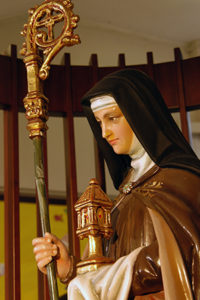
Clare came from a wealthy and noble family in Assisi. Her father died young. After hearing St. Francis of Assisi preach in the streets, she confided to him her desire to live for God, the two became close friends. On Palm Sunday 1212, the bishop presented her with a palm, which she apparently took as a sign. She eventually took the veil of religious profession from Francis at the Church of Our Lady of the Angels in Assisi.
She founded the Order of Poor Ladies (Poor Clares) at San Damiano, and led it for 40 years. Everywhere the Franciscans established themselves throughout Europe, there also went the Poor Clares, depending solely on alms, forced to have complete faith on God to provide through people; a lack of land-based revenues was a new idea at the time.
Clare loved music and well-composed sermons. She was humble, merciful, charming, optimistic, and chivalrous. She daily meditated on the Passion. When she learned of the Franciscan martyrs in Morrocco in 1221, she tried to go there to give her own life for God, but was restrained. Once when her convent was about to be attacked, she displayed the Sacrament in a monstrace at the convent gates, and prayed before it; the attackers left.
Toward the end of her life, when she was too ill to attend Mass, an image of the service would display on the wall of her cell; thus her patronage of television. She was ever the close friend and spiritual student of Francis, who apparently led her soul into the light.
| Born 16 July 1194 at Assisi, Italy |
Died 11 August 1253 of natural causes |
| Canonized 26 September 1255 by Pope Alexander IV |
Name Meaning bright; brilliant |
| Patronage embroiderers; eye disease; eyes; gilders; goldsmiths; gold workers; good weather; laundry workers; needle workers; Santa Clara Indian Pueblo; telegraphs; telephones; television; television writers |
|
| Representation host; monstrance; woman with a monstrance in her hand |
|


